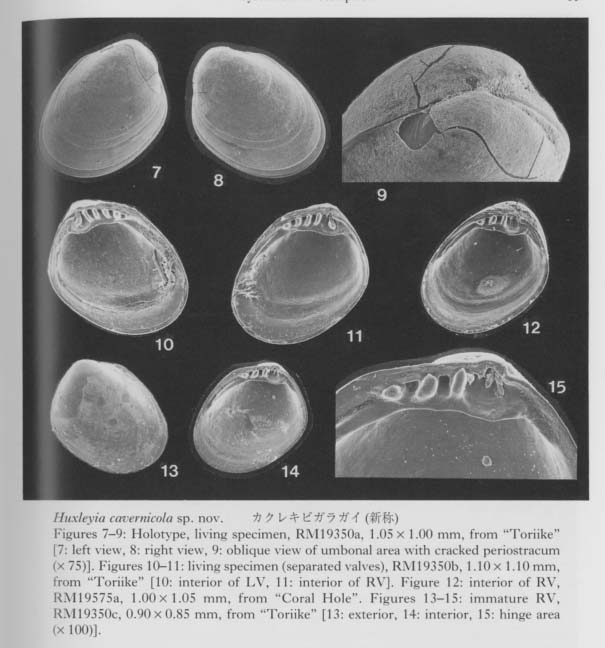Huxleyia cavernicola sp. nov.
Figures 7-15

1992. Huxleyia sp., Kase and Hayami, Jour. Moll. Studies, vol. 58, p.448, listed.
1993. Huxleyia sp., Hayami and Kase, Univ. Mus. Univ. Tokyo, News, no.27, p.3, fig.1.
Type and material.—Holotype: RM19350a, a living specimen from the bottom sediments of "Toriike" of Shimoji Islet. Miyako Islands. Paratypes: RM19347 (living) from "Devil's Palace", RM19348 (living) from "Fool's Palace", RM19349 (living) from "Witch's House", RM19350 (living) from the type locality, RM19351 (living) from "Black Hole", RM19575 (living) from "Coral Hole" of Shimoji Islet. RM19352 (living) from "Lunch Hole", RM19353 (living) from "W-arch", RM19574 (living) from "L-arch", RM19354 (living) from "Cross Hole" of Irabu Islet. RM19355 (dead) from "Shodokutsu" of Ie Islet.
Diagnosis.—Stunted species of Huxleyia, characterized by ovate outline, strong convexity, relatively short hinge line, large Pd I, thick, brownish (sometimes greenish) and shiny periostracum, and only four pre-umbonal teeth in each valve, of which the anteriormost tooth is commonly incipient.
Description.—Shell scarcely exceeds 1.2 mm in length and height, equivalve, opisthocline, considerably thick, obliquely elongated and ovate, slightly longer than high, strongly convex. Surface smooth except for growth-lines, covered with dark brownish (or greenish) thick periostracum. Hinge line relatively short, occupying about two-fifths of shell length. Antero-dorsal margin long, discriminated from dorsal margin by an obtuse angulation. Hinge plate broad, with large resilium pit below umbo and three or four opisthoclinal pre-umbonal teeth in each valve; two or three teeth near umbo obliquely elongated and stout, while the anteriormost tooth is commonly tubercular and incipient. RV has an elongated lateral tooth along the anterodorsal margin, and LV has a groove for its reception. Anterior adductor scar not strongly impressed but large and suboval, whereas posterior adductor is absent even in young individuals. Pd I very large, nearly smooth, ranging 247-276 µm in maximum diameter, hidden by periostracum; Pd II not discriminated.
Remarks.—A large number of individuals were found alive on the bottom sediments in many caves of Shimoji and Irabu. Islets. The present species is undoubtedly referable to Huxleyia by the completely internal ligament and characteristic hinge teeth. It resembles Cyrilla dalli Hedley, 1902, from eastern Australia in the small shell-size and the number of pre-umbonal teeth, but the shell is more obliquely elongated, and the antero-dorsal area is more clearly angulated. Cyrilla minuta Dall, 1898, from the Eastern Pacific and Nucinella (Huxleyia) ochiaiensis Chinzei, 1959, from the Pliocene of north Japan have less elongated outlines, larger shell size and commonly five or more pre-umbonal teeth in the adult stage.
In the outline it may be closer to Huxleyia sulcata Adams, 1860, from Japanese waters, but the adult shell size is smaller by half and the surface is not marked with strong commarginal lamellae. The pre-umbonal teeth are decidedly fewer; they number four in the adult stage (Figures 10, 11), while five to six teeth are commonly present in H. sulcata. There is a possibility that the present species is a paedomorphic form of some larger-sized species, but these features seem to deserve a distinction at the species level.
Distribution.—Common in sublittoral caves of Shimoji, Irabu and Ie Islets of the Ryukyu Islands. The present species also occurs in "Balicasag Cave" off Panglao Islet of Bohol Island, the Philippines.
Subclass Palaeotaxodonta Korobkov, 1954
Order Nuculoida Dall, 1889
Superfamily Nuculoidea Gray, 1824
Family Nuculidae Gray, 1824
Genus Pronucula Hedley, 1902
Pronucula is a small sized nuculid genus which seems to be characterized by small shell-size, arcuate (instead of angular) hinge-line, fine marginal crenulations and relatively small number of palaeotaxodont teeth. The resilifer is subvertical, flanked by a pair of tooth-like projections and different from the oblique chondrophore of Nucucla and Acila, while this is probably a paedomorphic feature. Pronucula, together with Austronucula, had been known predominantly from the lower neritic to abyssal substrates of the southern hemisphere (Hedley, 1902; Dell, 1956; Powell, 1958; Knudsen, 1970). Living and dead specimens of a representative species of this genus, though rather rare, occur in some caves of Ryukyu Islands, as described below.